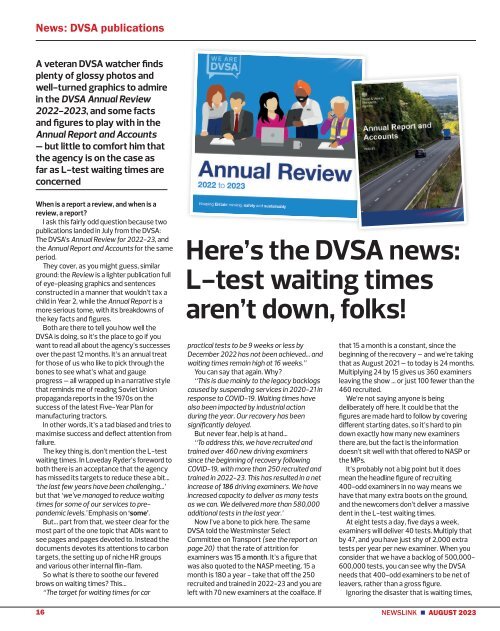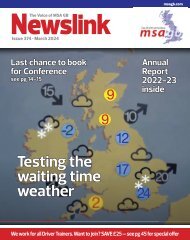Newslink August 2023
Motor Schools Association of Great Britain membership magazine; road safety; driving training and testing
Motor Schools Association of Great Britain membership magazine; road safety; driving training and testing
Create successful ePaper yourself
Turn your PDF publications into a flip-book with our unique Google optimized e-Paper software.
News: DVSA publications<br />
A veteran DVSA watcher finds<br />
plenty of glossy photos and<br />
well-turned graphics to admire<br />
in the DVSA Annual Review<br />
2022-<strong>2023</strong>, and some facts<br />
and figures to play with in the<br />
Annual Report and Accounts<br />
– but little to comfort him that<br />
the agency is on the case as<br />
far as L-test waiting times are<br />
concerned<br />
When is a report a review, and when is a<br />
review, a report?<br />
I ask this fairly odd question because two<br />
publications landed in July from the DVSA:<br />
The DVSA’s Annual Review for 2022-23, and<br />
the Annual Report and Accounts for the same<br />
period.<br />
They cover, as you might guess, similar<br />
ground: the Review is a lighter publication full<br />
of eye-pleasing graphics and sentences<br />
constructed in a manner that wouldn’t tax a<br />
child in Year 2, while the Annual Report is a<br />
more serious tome, with its breakdowns of<br />
the key facts and figures.<br />
Both are there to tell you how well the<br />
DVSA is doing, so it’s the place to go if you<br />
want to read all about the agency’s successes<br />
over the past 12 months. It’s an annual treat<br />
for those of us who like to pick through the<br />
bones to see what’s what and gauge<br />
progress – all wrapped up in a narrative style<br />
that reminds me of reading Soviet Union<br />
propaganda reports in the 1970s on the<br />
success of the latest Five-Year Plan for<br />
manufacturing tractors.<br />
In other words, it’s a tad biased and tries to<br />
maximise success and deflect attention from<br />
failure.<br />
The key thing is, don’t mention the L-test<br />
waiting times. In Loveday Ryder’s foreword to<br />
both there is an acceptance that the agency<br />
has missed its targets to reduce these a bit...<br />
‘the last few years have been challenging…’<br />
but that ‘we’ve managed to reduce waiting<br />
times for some of our services to prepandemic<br />
levels.’ Emphasis on ‘some’.<br />
But... part from that, we steer clear for the<br />
most part of the one topic that ADIs want to<br />
see pages and pages devoted to. Instead the<br />
documents devotes its attentions to carbon<br />
targets, the setting up of niche HR groups<br />
and various other internal flin-flam.<br />
So what is there to soothe our fevered<br />
brows on waiting times? This...<br />
“The target for waiting times for car<br />
Here’s the DVSA news:<br />
L-test waiting times<br />
aren’t down, folks!<br />
practical tests to be 9 weeks or less by<br />
December 2022 has not been achieved... and<br />
waiting times remain high at 16 weeks.”<br />
You can say that again. Why?<br />
“This is due mainly to the legacy backlogs<br />
caused by suspending services in 2020-21 in<br />
response to COVID-19. Waiting times have<br />
also been impacted by industrial action<br />
during the year. Our recovery has been<br />
significantly delayed.<br />
But never fear, help is at hand...<br />
“To address this, we have recruited and<br />
trained over 460 new driving examiners<br />
since the beginning of recovery following<br />
COVID-19, with more than 250 recruited and<br />
trained in 2022-23. This has resulted in a net<br />
increase of 186 driving examiners. We have<br />
increased capacity to deliver as many tests<br />
as we can. We delivered more than 580,000<br />
additional tests in the last year.’<br />
Now I’ve a bone to pick here. The same<br />
DVSA told the Westminster Select<br />
Committee on Transport (see the report on<br />
page 20) that the rate of attrition for<br />
examiners was 15 a month. It’s a figure that<br />
was also quoted to the NASP meeting. 15 a<br />
month is 180 a year - take that off the 250<br />
recruited and trained in 2022-23 and you are<br />
left with 70 new examiners at the coalface. If<br />
that 15 a month is a constant, since the<br />
beginning of the recovery – and we’re taking<br />
that as <strong>August</strong> 2021 – to today is 24 months.<br />
Multiplying 24 by 15 gives us 360 examiners<br />
leaving the show ... or just 100 fewer than the<br />
460 recruited.<br />
We’re not saying anyone is being<br />
deliberately off here. It could be that the<br />
figures are made hard to follow by covering<br />
different starting dates, so it’s hard to pin<br />
down exactly how many new examiners<br />
there are, but the fact is the information<br />
doesn’t sit well with that offered to NASP or<br />
the MPs.<br />
It’s probably not a big point but it does<br />
mean the headline figure of recruiting<br />
400-odd examiners in no way means we<br />
have that many extra boots on the ground,<br />
and the newcomers don’t deliver a massive<br />
dent in the L-test waiting times.<br />
At eight tests a day, five days a week,<br />
examiners will deliver 40 tests. Multiply that<br />
by 47, and you have just shy of 2,000 extra<br />
tests per year per new examiner. When you<br />
consider that we have a backlog of 500,000-<br />
600,000 tests, you can see why the DVSA<br />
needs that 400-odd examiners to be net of<br />
leavers, rather than a gross figure.<br />
Ignoring the disaster that is waiting times,<br />
16 NEWSLINK n AUGUST <strong>2023</strong>

















